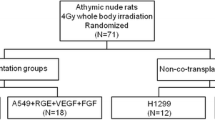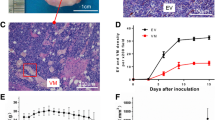Abstract
To evaluate the correlation between CT perfusion parameters and tumor angiogenesis, expression of VEGF is implanted in VX2 lung tumor. VX2 tumor cells were injected in 15 healthy New Zealand rabbits. After 20 days, tumors with diameter over 7 mm were scanned with 16 row spiral CT. Using Software Perfusion 3, blood flow (BF), blood volume (BV), permeability surface area product (PS), and the maximum attenuation value (MAV) were obtained. After CT examination, rabbit was sacrificed, and slices from tumor tissue were prepared and checked with immunohistochemical staining with anti-CD34 and anti-VEGF monoclonal antibodies. Correlation of CT perfusion parameters with MVD and VEGF expression was determined by using Pearson correlation analysis. Blood supply of tumor and regions around tumor was higher than that of normal lung tissue. PS value increased sharply in tumor tissue. PS value in regions around tumor was also higher than that of normal lung tissue but lower than that of tumor tissue. Significant positive correlation was observed between CT perfusion parameters (BF, BV, PS, and MAV) and expression of VEGF and MVD in tumor tissue. CT perfusion parameters provide reliable information of the microcirculation in tumor tissue; therefore, it can be used as indexes to characterize angiogenesis of tumor.


Similar content being viewed by others
References
Wen, C., & Dehnel, T. (2011). China wrestles with lung cancer. Lancet Oncology, 12(1), 15.
Hashizume, H., Falcón, B. L., Kuroda, T., et al. (2010). Complementary actions of inhibitors of angiopoietin-2 and VEGF on tumor angiogenesis and growth. Cancer Research, 70(6), 2213–2223.
Leow, C. C., Coffman, K., Inigo, I., et al. (2012). MEDI3617, a human anti-angiopoietin 2 monoclonal antibody, inhibits angiogenesis and tumor growth in human tumor xenograft models. International Journal of Oncology, 40(5), 1321–1330.
Falcón, B. L., Hashizume, H., & Koumoutsakos, P. (2009). Contrasting actions of selective inhibitors of angiopoietin-1 and angiopoietin-2 on the normalization of tumor blood vessels. American Journal of Pathology, 175(5), 2159–2170.
Bradley, D. J., leum, W. N., Purdy, J. A., et al. (2002). Gross tumor volume, critical prognostic factor in patients treated with three-dimensional conformal radiation therapy for non-small cell lung carcinoma. International Journal of Radiation Oncology Biology Physics, 52, 47–49.
Grills, I. S., Yan, D., Martinez, A. A., Vicini, F. A., et al. (2003). Potential for reduced toxicity and dose escalation in the treatment of inoperable non-small-cell lung cancer: A comparison of intensity-modulated radiation therapy (IMRT), 3D conformal radiation, and elective nodal irradiation. International Journal of Radiation Oncology Biology Physics, 57(3), 875–890.
Bradley, J. D., Wahab, S., Lockett, M. A., et al. (2003). Elective nodal failures are uncommon in medically inoperable patients with Stage I non-small-cell lung carcinoma treated with limited radiotherapy fields. International Journal of Radiation Oncology Biology Physics, 56(2), 342–347.
Moreno-Jiménez, M., Aristu, J., López-Picazo, J. M., et al. (2008). Dosimetric analysis of the patterns of local failure observed in patients with locally advanced non-small cell lung cancer treated with neoadjuvant chemotherapy and concurrent conformal (3D-CRT) chemoradiation. Radiotherapy and Oncology, 88(3), 342–350.
Lee, S. W., Choi, E. K., Lee, J. S., Lee, S. D., Suh, C., et al. (2003). Phase II study of three-dimensional conformal radiotherapy and concurrent mitomycin-C, vinblastine, and cisplatin chemotherapy for Stage III locally advanced, unresectable, non-small-cell lung cancer. International Journal of Radiation Oncology Biology Physics, 56(4), 996–1004.
Chan, R., He, Y., & Haque, A. Z. (2001). Computed tomographic-pathologic correlation of gross tumor volume in non-small cell lung cancer: A pilot experience. Archives of Pathology and Laboratory Medicine, 125, 1469–1472.
Harvey, C. J., Blomley, M. J. K., Dawson, P., et al. (2001). Functional CT imaging of the acute hyperemic response to radiation therapy of the prostate gland: Early experience. JCAT, 25, 43–49.
Chao, Ks, Bosch, W. R., Mutic, S., et al. (2001). A novel approach to overcome hypoxic tumor resistance: CU-ATSM-guided intensity-modulated radiation therapy. International Journal of Radiation Oncology Biology Physics, 49, 1171–1182.
Hermans, R., Lambin, P., Bogert, V. D. W., et al. (1997). Non-invasive tumor perfusion measurement by dynamic CT: Preliminary results. Radiation Oncology, 44, 159.
Hermans, R., Meurink, M., Bogaert, V. D. W., et al. (2003). Tumor perfusion rate determined noninvasive by dynamic computer tomography predicts outcomes in head-and neck cancer after radiotherapy. International Journal of Radiation Oncology Biology Physics, 57, 1351–1356.
Wenz, F., Rempp, K., Heb, T., et al. (1996). Effect of radiation on blood volume in low-brain astrocytomas and normal brain tissue: Quantification with dynamic susceptibility contrast MR imaging. AJR., 166, 183–187.
Hermans, R., Lambin, P., & Van der Goten, A. (1999). Tumoural perfusion as measured by dynamic computed tomography in head and neck carcinoma. Radiotherapy and Oncology, 53(2), 105–111.
Hermans, R. (2001). Op de beeck K, Van den Bogaert W, The relation of CT-determined tumor parameters and local and regional outcome of tonsillar cancer after definitive radiation treatment. International Journal of Radiation Oncology Biology Physics, 50(1), 37–45.
Kuhnt, T., Mueller, A. C., Pelz, T., et al. (2005). Impact of tumor control and presence of visible necrosis in head and neck cancer patients treated with radiotherapy or radiochemotherapy. Journal of Cancer Research and Clinical Oncology, 131(11), 758–764.
van den Broek, G. B., Rasch, C. R., Pameijer, F. A., et al. (2004). Pretreatment probability model for predicting outcome after intraarterial chemoradiation for advanced head and neck carcinoma. Cancer, 101(8), 1809–1817.
Nguyen, N. P., Moltz, C. C., Frank, C., et al. (2004). Dysphagia following chemoradiation for locally advanced head and neck cancer. Annals of Oncology, 15(3), 383–388.
Tateishi, Ukihide, Kusumoto, Masahiko, Nishihara, Hiroshi, et al. (2002). Contrast-enhanced dynamic computed tomography for the evaluation of tumor angiogenesis in patients with lung carcinoma. Cancer, 95(4), 835–843.
Sun, C. J., Yang, Z. G., Zhou, X. P., et al. (2007). Non-small cell lung cancer evaluated by first pass dynamic contrast-enhanced 16-slice spiral CT: Correlation of tumor vascularity with pathological characteristics. Zhonghua Zhong Liu Za Zhi., 29(6), 429–433.
Li, Y., Yang, Z. G., Chen, T. W., et al. (2008). Peripheral lung carcinoma: Correlation of angiogenesis and first-pass perfusion parameters of 64-detector row CT. Lung Cancer, 61(1), 44–53.
Liu, J., Xiong, Z., Hu, C., et al. (2010). Correlation between multi-slice spiral CT pulmonary perfusion imaging and cavity of microvessel in lung cancer. Zhong Nan Da Xue Xue Bao Yi Xue Ban., 35(12), 1242–1247.
Author information
Authors and Affiliations
Corresponding author
Rights and permissions
About this article
Cite this article
Ling, S., Deng, D., Mo, Y. et al. Correlations Between CT Perfusion Parameters and Vascular Endothelial Growth Factor Expression and Microvessel Density in Implanted VX2 Lung Tumors. Cell Biochem Biophys 70, 629–633 (2014). https://doi.org/10.1007/s12013-014-9966-8
Published:
Issue Date:
DOI: https://doi.org/10.1007/s12013-014-9966-8




